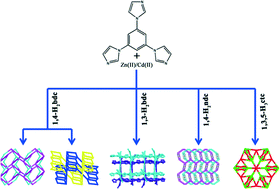A series of d10 coordination polymers constructed with a rigid tripodal imidazole ligand and varied polycarboxylates: syntheses, structures and luminescence properties†
Abstract
Five novel Zn(II)/Cd(II) coordination polymers, [Zn2(tib)(L1)(μ2-OH)(HCOO)·2H2O]n (1), [Cd2(tib)2(L1)(NO3)2·2H2O·4DMF]n (2), [Cd2(tib)2(L2)(NO3)2·2H2O·4DMF]n (3), [Cd(tib)(L3)·H2O·2DMF]n (4) and [Cd3(tib)4(L4)·5/2NO3·1/2OH·3DMF]n (5) (tib = 1,3,5-tris(1-imidazolyl)benzene, H2L1 = terephthalic acid, H2L2 = isophthalic acid, H2L3 = 1,4-naphthalenedicarboxylic acid, H3L4 = (1α,3α,5α)-1,3,5-cyclohexanetricarboxylic acid, DMF = N,N-dimethylformamide), have been synthesized under solvothermal conditions. In compound 1, two-dimensional (2D) Zn-tib layers are pillared by L1 to afford a (3,5)-connected three-dimensional (3D) framework with topology (63)(69·8). Compound 2 displays a 2D + 2D → 2D interpenetrated bi-layer array based on a 2D (3,4) network. Compound 3 is characterized as an infinite one-dimensional (1D) chain structure, which is further extended into a 3D supramolecular architecture via weak π⋯π stacking interactions. Compound 4 possesses a 3D 2-fold interpenetrated architecture with the Schläfli symbol (42·65·83)(42·6). Compound 5 features a fascinating petal shaped (3,5)-connected network with a (42·6·84·103)3(42·6)3(83)2 topology which until now has never been documented. In this series of compounds, the diversity of the structures is tuned by the coordination geometries of the metal ions and the nature of the varied co-ligands. Furthermore, the luminescence properties of compounds 1–5 at room temperature have also been studied in detail.


 Please wait while we load your content...
Please wait while we load your content...